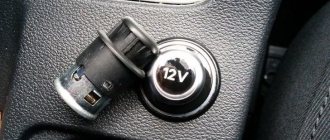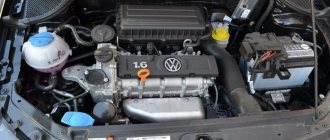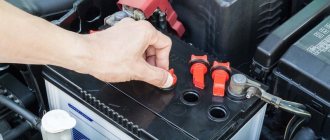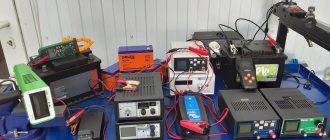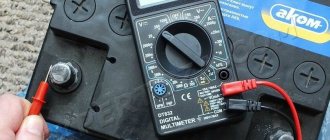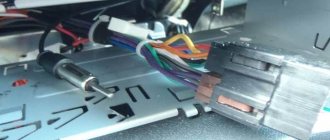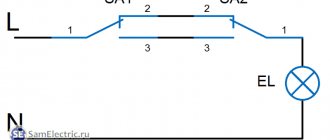Observing the change in the value of an expression depending on the order in which arithmetic operations are performed
In life, we constantly perform some kind of action: we walk, study, read, write, count, smile, quarrel and make peace. We perform these actions in different orders. Sometimes they can be swapped, sometimes not. For example, when getting ready for school in the morning, you can first do exercises, then make your bed, or vice versa. But you can’t go to school first and then put on clothes.
In mathematics, is it necessary to perform arithmetic operations in a certain order?
Let's compare the expressions: 8-3+4 and 8-3+4
We see that both expressions are exactly the same.
Let's perform actions in one expression from left to right, and in the other from right to left. You can use numbers to indicate the order of actions (Fig. 1).
Rice. 1. Procedure
In the first expression, we will first perform the subtraction operation and then add the number 4 to the result.
In the second expression, we first find the value of the sum, and then subtract the resulting result 7 from 8.
We see that the meanings of the expressions are different.
Let us conclude: the order in which arithmetic operations are performed cannot be changed .
Order of arithmetic operations in expressions with parentheses
Expressions often contain parentheses to indicate the order in which actions are performed. In this case , the rule that specifies the order of execution of actions in expressions with parentheses
, is formulated as follows: first, the actions in brackets are performed, while multiplication and division are also performed in order from left to right, then addition and subtraction.
So, the expressions in brackets are considered as components of the original expression, and they retain the order of actions already known to us. Let's look at the solutions to the examples for greater clarity.
Follow these steps 5+(7−2·3)·(6−4):2.
The expression contains parentheses, so let's first perform the actions in the expressions enclosed in these parentheses. Let's start with the expression 7−2·3. In it you must first perform multiplication, and only then subtraction, we have 7−2·3=7−6=1. Let's move on to the second expression in brackets 6−4. There is only one action here - subtraction, we perform it 6−4 = 2.
We substitute the obtained values into the original expression: 5+(7−2·3)·(6−4):2=5+1·2:2. In the resulting expression, we first perform multiplication and division from left to right, then subtraction, we get 5+1·2:2=5+2:2=5+1=6. At this point, all actions are completed, we adhered to the following order of their implementation: 5+(7−2·3)·(6−4):2.
Let's write down a short solution: 5+(7−2·3)·(6−4):2=5+1·2:2=5+1=6.
It happens that an expression contains parentheses within parentheses. There is no need to be afraid of this; you just need to consistently apply the stated rule for performing actions in expressions with brackets. Let's show the solution of the example.
Perform the operations in the expression 4+(3+1+4·(2+3)) .
This is an expression with brackets, which means that the execution of actions must begin with the expression in brackets, that is, with 3+1+4·(2+3) . This expression also contains parentheses, so you must perform the actions in them first. Let's do this: 2+3=5. Substituting the found value, we get 3+1+4·5. In this expression, we first perform multiplication, then addition, we have 3+1+4·5=3+1+20=24. The initial value, after substituting this value, takes the form 4+24, and all that remains is to complete the actions: 4+24=28.
In general, when an expression contains parentheses within parentheses, it is often convenient to perform actions starting with the inner parentheses and moving to the outer ones.
For example, let's say we need to perform the actions in the expression (4+(4+(4−6:2))−1)−1. First, we perform the actions in the inner brackets, since 4−6:2=4−3=1, then after this the original expression will take the form (4+(4+1)−1)−1. We again perform the action in the inner brackets, since 4+1=5, we arrive at the following expression (4+5−1)−1. Again we perform the actions in brackets: 4+5−1=8, and we arrive at the difference 8−1, which is equal to 7.
Do-it-yourself battery replacement
You like to tinker on your own, especially since changing the battery is very easy. I am writing step by step.
For older vehicles without electronic control systems
For a car without complex, rich electronics. You come to a store where they sell batteries, discuss it with the manager and choose the battery that suits you.
Open the hood, first removing the key from the ignition. You will need a 10mm open end wrench to unscrew the terminals and another wrench to remove the fasteners from the battery itself, this could be a 12-13mm wrench. Wear gloves to protect your skin from dirt and oxidation products. Using a 10mm wrench, loosen the nut of the wire end coupling bolt. Disconnect the wire from the negative terminal of the battery.
Battery removal procedure
It is important to remember how to properly remove the terminals from the battery. There is a certain order of actions that must be followed. At the same time, do not forget about safety precautions. The sequence of actions is as follows:
- First you need to turn off the car.
- Turn off all electronic devices.
- Close windows and doors: if the car has power windows, after removing the battery, the windows will not be able to be raised. The doors will have to be closed manually with a key.
- Remove the cover protecting the battery terminals from dust and dirt.
- If there is no cover, you need to insulate the positive terminal with electrical tape.
- Remove grounding, if present.
- Loosen the nuts with a wrench.
- Disconnect the negative terminal, then the positive one.
- Do not allow the positive terminal to come into contact with metal objects.
An important technical point: it is the negative that needs to be disconnected first, so that a short circuit does not occur.
The car body, also called the ground, is connected to the negative terminal. When it is removed, the circuit is broken and a short circuit cannot occur, since the battery is disconnected from the body.
We recommend: How much electrolyte is in the battery 55: liter volume
Thus, removing the terminal from the battery is easy. You just need to strictly follow the sequence of actions .
Next, you should take the necessary actions: recharge the battery or replace it with a new one.
Which terminal to put on the battery first?
The battery installation process requires no less attention than the removal process. Here you also need to correctly determine which terminal to put on first so that there is no risk of a short circuit.
Above, the information about which terminal should be removed first contains an explanation of why it is advisable to leave only the “plus” connected to the battery. Accordingly, the “plus” terminal should be put on the battery first, and only then the “minus” terminal should be put on.
Important: Unlike the process of removing a battery, installing it is a much more potentially dangerous process. Here you cannot first add “minus” and then “plus”, otherwise there is a high risk of damage to the on-board network.
Treatment
To ensure perfect contact, the outputs must be cleaned
.
To do this, they are covered with ordinary baking soda
. The same is done with the terminals. Take a special brush - it is sold in any car store and costs a penny, but it is a very useful thing for household use.
If you don't have one, be sure to buy it. It looks like it consists of two parts: one with a hard “pile”, the second is narrow, slipping into any cracks.
Too lazy to buy such a useful tool - make do with an old toothbrush
. True, her bristles are too soft, so it will take longer to fiddle with. A brush is used to clean off all excess from the terminals and terminals, after which they are washed with distilled water - it is more convenient to use a spray bottle. You can, in principle, use ordinary water, but it can form salts if you have not removed the moisture well enough.
When the required degree of cleanliness is achieved, all drops are wiped dry with a clean rag, and the terminals and terminals are lubricated with an anti-corrosion agent. It’s up to you to choose which one, but at least technical Vaseline should be used.
How to properly connect a car battery
To turn off the battery, follow these guidelines:
- To connect the power source, you first need to take the terminal of the positive wire, which comes from the electrical circuits of the car, and put it on the plus of the battery. You need to loosen the nut on the terminal and make sure that the terminal goes all the way down.
- After this, using a wrench, you need to tighten the terminal with a nut until the terminal becomes motionless. To check, you need to shake the terminal by hand and tighten it again.
- The negative wire must be installed the same as the positive wire. Place the negative wire with a terminal that fits from the car body and tighten it with a wrench.
- If any terminal does not reach the battery, this means that the power source is not in the right place. It is necessary to place the battery in its seat.
- After connecting the two terminals, you need to turn off the alarm and try to start the car. If the car does not start, you need to check the connection on the battery, on the generator, as well as the negative wire to ensure that it is securely attached to the body.
If after this the car does not start, it means either the power source is discharged or the battery has lost its functionality.
Types and design of power supplies
There are the following types of car batteries:
- Lead-acid battery. This power supply consists of a plastic housing with six cells. The body contains lead plates, and each cell is filled with electrolyte in the form of liquid acid.
- Under conditions of proper maintenance and operation, the service life reaches 5 years from the date of purchase.
- Lead non-woven AGM battery. The AGM power source is an advanced lead-acid battery. Thanks to improved characteristics and power, the starting current has increased. The AGM battery has a one-piece closed housing and does not require maintenance. Most often used on electric vehicles.
- Lead-helium battery. In an ordinary lead-acid battery, the acid is in liquid form in the housing. In a lead-helium battery, sulfuric acid and silica change from a liquid to a gel. This invention is suitable for those who need to use the battery in a lying or inclined position due to conditions associated with the design. The power supply is housed in a closed housing and does not require maintenance.
- Traction batteries. The most powerful power source, one of the best as of 2021. Used on electric vehicles. Can continuously supply electrical energy to the electric vehicle and withstand multiple charge and discharge cycles. The traction battery provides voltage from 24 V to 96 V and an electrical charging capacity of up to 1000 Ah. The service life is more than 10 years.
Battery connection
When installing the battery, you need to check the condition of the wires leading to it, clean the clamps from corrosion and lubricate the clamping screws. To properly connect the battery in a car, you first need to make sure that no one is in the car, since the connection may activate the airbags. All actions must be performed in the reverse order to what was done during removal. The sequence of connecting the battery terminals should be as follows:
When you first turn on the ignition after installing the battery, you must be outside the car. After installing the battery, you should check the operation of the lighting devices. To do this, it is necessary, without starting the engine, to check that the low and high beam headlights are on, the operation of the windshield wipers, and the hazard warning lights. If you connect the battery correctly, then everything in the car should work properly. To configure the on-board computer after connecting the power, you need to take the following steps:
The test ride must be at least 10 kilometers.
To properly connect the battery to a VOLVO car, you need to follow some rules:
If the car has a remote start system, then when the power is turned off, the access password will be reset to factory settings.
Sequencing
We’ll omit the introductory part about finding the battery - I think that if you’ve had the car for more than a day, you already know where it is. If the battery is covered with a cover (factory or homemade), it must be removed. If the machine is grounded, the grounding is disconnected first. There is a lot of controversy surrounding the terminal disconnection sequence. What is removed first, plus or minus? Definitely a minus! By disconnecting the negative terminal, you leave ground without potential. So even an accidental touch of the positive terminal will not cause a short circuit.
Before turning off, if the “plus” is open (the “original” cover has been lost), you need to wrap it with a rag or put on a plastic cap from a bottle of detergent - then it will definitely not pull while you are fiddling with the “minus”.
